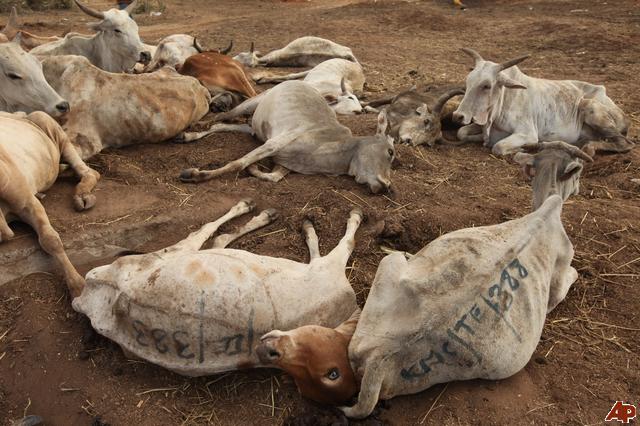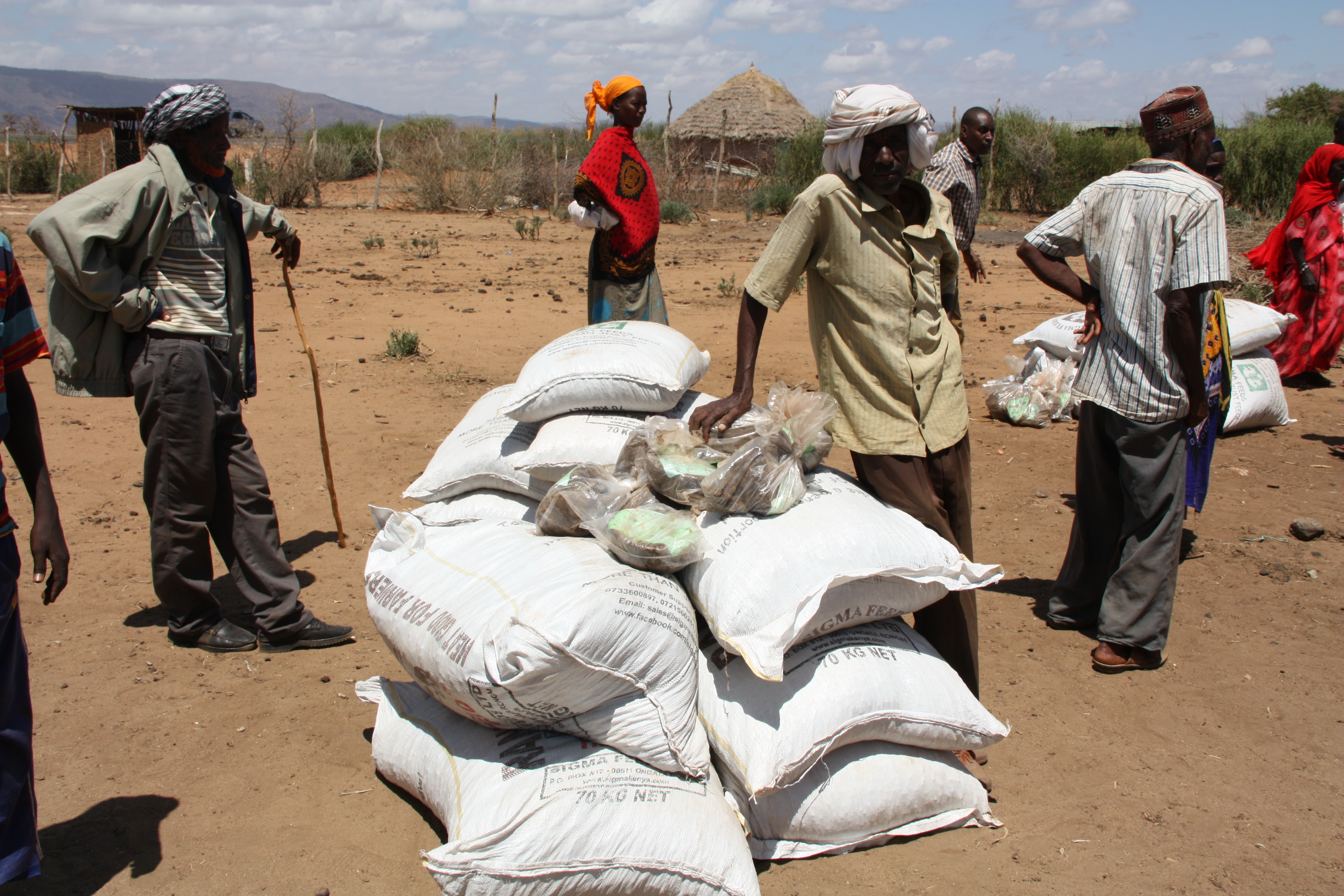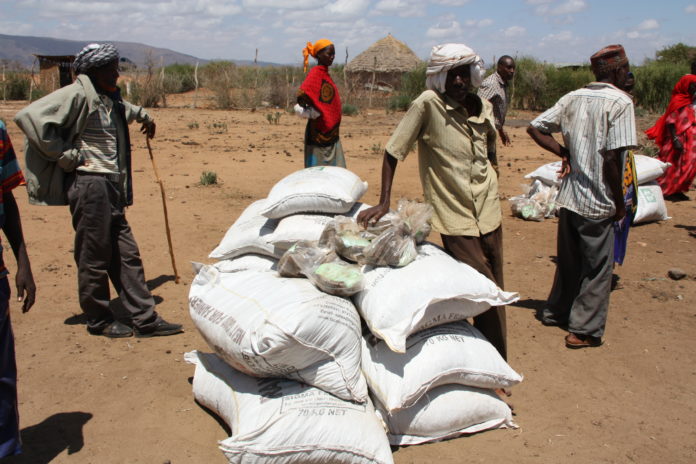By Ruth Lehmann
In response to the significant livestock mortality, which has resulted from the drought, The Food and Agriculture Organization of the United Nations (FAO) together with the State Department of Livestock have today flagged off a consignment of enough animal feed to sustain the targeted animals over a period of about two months. The 800 bags of ranch cubes and 6,400 multi-nutrient feed-blocks will be distributed to 156 and 640 households respectively in drought-affected areas of Wajir County. The event took place at the KALRO Muguga Campus, where the feed is being manufactured using an FAO formula.
The Principal Secretary at the State of Department of Livestock within the Ministry of Agriculture Livestock and Fisheries Dr. Andrew Tuimur officiated the event, together with Dr. Piers Simpkin, head FAO-Kenya’s livestock sector.
Speaking to the press, Dr. Tuimur emphasized that the government’s intervention is still going on “The Government is supplying water, fodder, vaccines and other livestock supplements to the twenty-three affected counties,” he said, adding that the current rains that have begun in certain parts of the country are scarce, with the drought situation expected to persist.

The three-month vegetation condition index released by the National Drought Management Authority this week (27th March 2017) currently indicates severe vegetation deficit, demonstrating a “significant worsening trend with all sub-counties in the severe band, except Wajir South that is now in the extreme vegetation category”.
FAO’s livelihood support in response to the drought in Kenya
FAO’s distribution of feed intended for breeding animals has been on-going since mid-March in affected counties of Wajir, Marsabit, Kwale and Kilifi – targeting the worst hit areas to mitigate further deaths of livestock and ensure regeneration of the herds. The first batch of 2,000 bags (70 kg-bags of concentrates or range cubes) and 16,000 multi-nutrient blocks targeting 10,000 households have been distributed in the four counties. The nutritionally balanced animal feeds are expected to help households maintain their livestock as offtake and other measures continue.
The distribution is part of FAO’s Early Warning, Early Action funding mechanism that was granted late last year in Kenya and other parts of the Horn of Africa to help reduce drought disaster impacts. The funds are being used to support the marketing of livestock, facilitate emergency water provision through the supply of fast-moving spare parts for boreholes and provide emergency animal health treatments to sustain livestock through the drought in the four counties.
FAO continues to raise funds for livelihood interventions in the most affected counties, and has appealed to the international donor community for USD 30 million for emergency response in 2017. To-date, this is less than five percent funded, representing a significant challenge to safeguarding the food security and incomes of drought-affected households in the arid and semi-arid areas of Kenya.
FAO and the Government of Kenya recently signed a Technical Cooperation Programme agreement to provide immediate livelihood assistance for vulnerable drought-affected families towards drought response in the country. The main activities of the project include provision of animal feeds (including hay bales and high-fibre ranch cubes) as well as community water tanks in three targeted counties: Marsabit, Kwale and Isiolo.
The project will also provide emergency support to approximately 2,000 smallholder farmers who keep animals and improve water access for up to 10,000 breeding stock through the installation of 30 community water tanks in Isiolo and Marsabit counties. In addition, FAO will deliver an additional 300 tonnes of animal feed and 200 tonnes of high-fibre ranch cubes to 545 drought-affected households in Marsabit, Kwale and Isiolo. Emergency feed distributions are expected to feed up to a total of 65,540 breeding animals until pastures are expected to fully regenerate in June.

In drought-affected pastoral areas, where livestock production constitutes the backbone of the economy and is the main source of livelihood for the population, both rapid feed provision and improved water access is likely to save animal lives and sustain production. Some of the affected pastoralists fully rely on their livestock for food –milk, meat and blood – or sell/exchange livestock for grains and animal feed. The northern and coastal areas of Kenya are facing widespread drought as a result of poor performance of the October–December 2016 short rains which followed an already long dry season and suppressed main season long rains in March-May 2016 affecting farmers and pastoralists.
Kenya government intervention
On the 10th of February 2017, the Government declared the ongoing drought a National Disaster, with approximately 2.7 million people affected. A response plan of USD 263 million to be implemented over nine months to respond to humanitarian needs in drought-affected areas has been put in place. The three-phase plan has committed USD 159 million for Phases I and II.
Of the Government’s response plan, USD 30.6 million is dedicated to livestock response. In addition, the Government has paid out insurance to 11 000 households, totalling USD 2 million. Earlier this month, UN agencies and partners made a Flash Appeal in response to the Government of Kenya’s declaration of the drought calling for USD 46 million to complement government response. Top priorities to address livestock-related crisis are feed, livestock off-take and animal health. According to the UN Office for the Coordination of Humanitarian Affairs (OCHA) livestock prices have dropped by up to 90 per cent in some areas whilst mortality rates are increasing. Loss of livestock assets is associated with negative coping mechanisms that lead to poverty and eventual migration into informal relief camps or cities.
The next major harvest in the ASALs is not expected until February 2018, while the situation of pastures is not expected to improve until June 2017. Livestock-holding households urgently need access to survival and supplementary feeding as well as water until pastures are able to fully regenerate. The short rains assessment conducted in February 2017 revealed yields 30–50 percent below average, poor to very poor availability of pasture and water, deterioration and death of livestock. Below-average harvests have contributed to the rising cost of cereals and low livestock production has resulted in minimal meat, milk and other animal product availability.
Our Guest Writer is Ruth Lehmann a Communications Manager at – FAO Kenya














